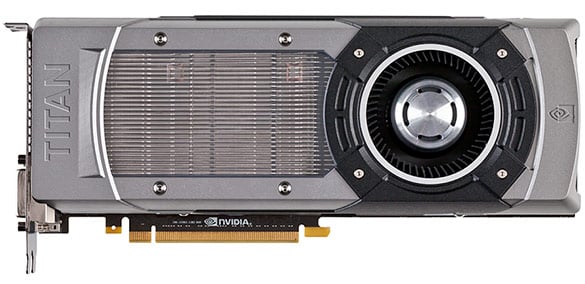NVIDIA GeForce GTX Titan Powered Maingear SHIFT
The GeForce GTX Titan
The new NVIDIA GeForce GTX Titan’s design language is similar to the company’s current flagship dual-GPU powered GeForce GTX 690, but there are some obvious departures due to the vastly different card configurations.
As was listed in the specifications a couple of pages back, the GeForce GTX Titan is outfitted with a GK110 GPU, with a base clock of 836MHz and a Boost click of 876MHz. The card’s massive 6GB frame buffer is clocked at 6008MHz (effective GDDR5 data rate) and the memory links to the GPU via a wide 384-bit interface. At those clocks, the GeForce GTX Titan offers up a peak textured fillrate of 187.5 GTexels/s, 4500 GFLOPS of compute performance, and 288.4 GB/s of memory bandwidth, which should make the Titan the fastest single-GPU powered card available today.
Like the GeForce GTX 690, the GeForce GTX Titan is outfitted with a base frame made of aluminum to add rigidity. And the card has a metal fan housing as well. The GeForce GTX logo along the top edge of the card lights up like the GTX 690's too, though brightness can be controlled on the Titan.
The actual cooling hardware on the GTX Titan consists of a large vapor chamber with a densely packed, nickel-plated aluminum finstack, and large rear-mounted barrel-type fan with user-adjustable fan curves. Like the GeForce GTX 690, the Titan also uses low-profile components on about the front 65% of the PCB around the GPU and the card’s cooler has a flat, ducted baseplate for unobstructed airflow, which minimizes turbulence and helps quiet down and better cool the card. There is a window cut into the fan shroud that shows off the finstack (under a Lexan window), and due to the fan configuration, virtually all of the heat produced by the card is exhausted from a system. The GeForce GTX 690, with its centrally mounted axial-type fan, would expel half of the heated air from the system and dump the other half into the case. Again, Titan's design pushes all airflow outside the system it's installed in.
As evidenced by the pair of SLI edge connectors at the top of the card, the GeForce GTX Titan supports up to 3-Way SLI, and because the TDP of the card is only 250 watts, single 8-pin and 6-pin supplemental PCI Express power feeds are all that are required to power the Titan.
Outputs consist of a pair of dual-link DVI outputs, a full-sized DisplayPort output, and an HDMI connector. The GeForce GTX Titan should have more than enough muscle to push multiple displays simultaneously, and as such it, supports NVIDIA's 3D Vision Surround technology.












